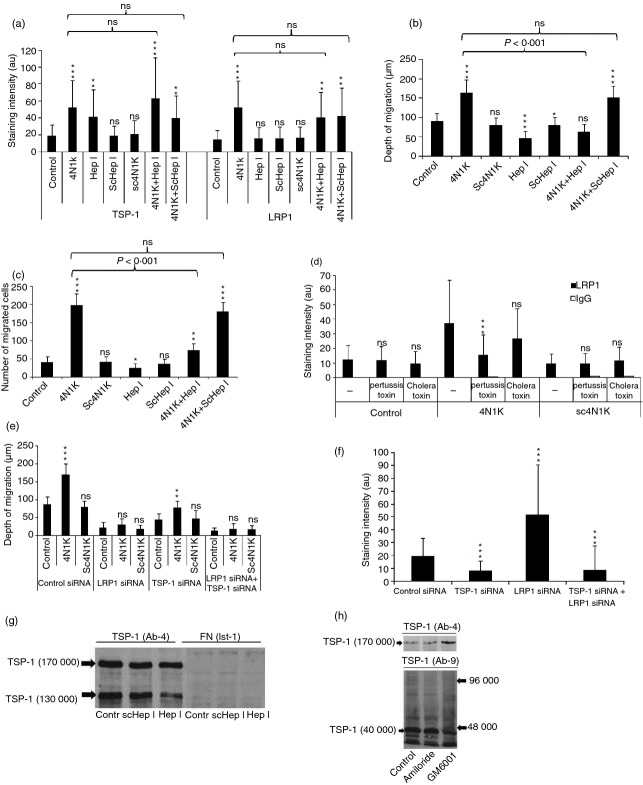Figure 4.
Thrombospondin 1 (TSP-1) stimulates T-cell motility through CD47 and low-density lipoprotein receptor-related protein 1 (LRP1). (a) The influence of peptides mimetic of the CD47-binding site in TSP-1 (4N1K), the calreticulin-binding site of TSP-1 (hepI), and scrambled (sc) control peptides on the cell surface expression of TSP-1 and LRP1 as determined after 30 min using quantitative immunocytochemistry. (b, c) The influence of 4N1K, sc4N1K, hepI and sc hepI on T-cell motility measured as maximal depth of migration into a collagen gel (b) and number of cells at different levels throughout the gel (c) after 30 min. (d) Influence of incubation with pertussis toxin (10 μg/ml) or cholera toxin (10 μg/ml) on 4N1K-induced cell surface expression of LRP1 as determined after 30 min by quantitative immunocytochemistry. The results show mean values of three independent experiments. (e) The influence of 4N1K and sc4N1K on T-cell motility measured as maximal infiltration depth into a collagen gel after transfection with scrambled control small interfering (si) RNA, TSP-1 siRNA, LRP1 siRNA or both LRP1 siRNA and TSP-1 siRNA. The cells were allowed to migrate for 30 min. (f) The influence of transfection with scrambled control siRNA, TSP-1 siRNA, LRP1 siRNA or both LRP1 siRNA and TSP-1 siRNA on the cell surface expression of TSP-1. (g) Western blotting (6% SDS–PAGE) of material from lysed cells showing that incubation with hepI, but not a scrambled control peptide, for 15 min inhibits a 130 000 MW TSP-1 fragment. The reactivity with anti-fibronectin antibodies is shown as a control. (h) Western blotting (6% SDS–PAGE) of material from lysed cells demonstrating a 40 000 MW N-terminal fragment with a monoclonal antibody specific for the N-terminal domain (AB-9). It can further be seen that GM6001 (10 μm) but not amiloride (50 μm) inhibits this fragment and increases the intensity of intact 170 000 MW TSP-1 as demonstrated using another TSP-1 antibody (Ab-4). The results in (a–e) represent mean values of three individual experiments; (f–h) are representative of four or five individual experiments. *, **, *** refer to statistical comparisons with control cells.

